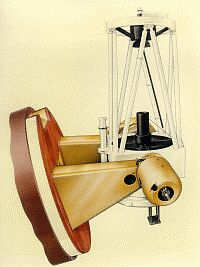Isaac Newton
Telescope
The Mounting
 The telescope has a polar disc/fork type
equatorial mounting supported by five axial and three radial hydrostatic
oil bearing pads. The tube, a conventional open Serrurièr truss
structure, supports the prime-focus assembly or secondary mirror for Cassegrain
and Coudé operation. The telescope has a polar disc/fork type
equatorial mounting supported by five axial and three radial hydrostatic
oil bearing pads. The tube, a conventional open Serrurièr truss
structure, supports the prime-focus assembly or secondary mirror for Cassegrain
and Coudé operation.
Declination coverage was improved when moved to La Palma by cutting a sector
out of the polar disc, and by a redesign of the dome aperture (a proposal to
remount the telescope on an altazimuth mount was found to have some
attractive features, but was rejected because of extra costs.) Drive limits are currently set at -30 degrees
Declination, 70 degrees zenith distance and ±6h Hour Angle (operation
below the pole is also possible).
DC servo motors with integral tachogenerators
are used for the slow-motion drives on both arms. The RA axis is driven
by a worn/worm-wheel assembly and the Declination axis by a recirculating
ball screw and nut. Preload and quick motion drive are provided by a pair
of motors driving through spur gearing.
The telescope's position is determined
by Moiré fringe grating encoders mounted on each axis. There are
three reading heads per axis. One bit corresponds to 0.3 arc sec in RA
and 1 arc sec in Declination, although systematic errors are larger. When
the telescope is being driven by the slow-motion motors, optical incremental
encoders are used, with resolutions of 0.01875 and 0.01 arc sec in RA and
Declination, respectively, mounted on the drive shafts.
The pointing model for the INT
comprises the standard errors of an equatorially mounted telescope (offsets
in Hour Angle and Declination, collimation error, misalignment of the
polar axis and non-perpendicularity of axes), together with an empirical
(Fourièr series and polynomial) model of flexure in the telescope
structure and large-scale errors in the encoder readings. The r.m.s.
errors in the absolute pointing of the INT are always less than 5 arc
sec; values between 2.8 and 4.5 arc sec were obtained during tests at
Prime and Cassegrain foci during 1985. Short-term tracking errors are
less than 0.25 arc sec; longer-term drifts are removed by the autoguiders.
Telescope limits:
- Zenith distance < 70°
- - 6 h < hour angle < + 6 h (above pole)
- Declination > -30° 09' 30"
Operation below the pole is possible, but only gains a small extra area of
sky; consider it in exceptional circumstances.
The lower windshield causes vignetting for zenith distances >
57° and is raised for such observations.
| 
